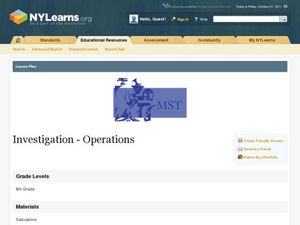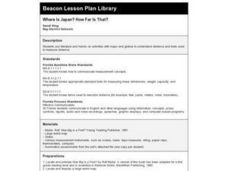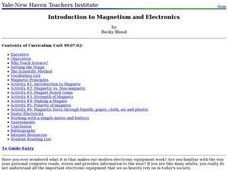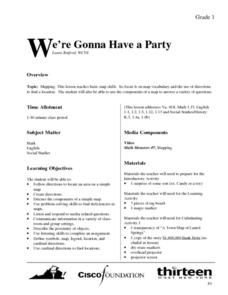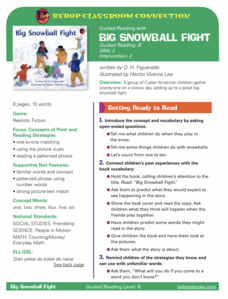Curated OER
Geo-Folder
Second graders create a Geo-Folder based on geometric terms and concepts. They make a Table of Contents that guides them through the process of assembling a folder of completed activities.
Curated OER
The Great Chile Challenge
Fifth graders gather data, create a graph, and interpret information. They build vocabulary by negotiating the ideas that go into the graphs which they create. They use Excel to print a variety of graphs based on how much they like Chile...
Curated OER
Geometric Figures
Students identify two and three dimensional shapes and use appropriate geometric vocabulary to write a description of the figure by taking pictures of geometric figures in their own environment.
Curated OER
Anchoring Numbers to Five and Ten
Students complete activities to relate numbers to each other. In this number connection lesson, students count number sets, count forward and backward, and complete other number recognition activities to learn how numbers are related.
Curated OER
Investigation-Operations
Sixth graders explore equations. For this math lesson, 6th graders discuss the rules for solving equations. Students apply the rules and solve various equations.
Alabama Learning Exchange
Is It a Triangle?
Students explore the concept of triangle inequalities. In this triangle inequality lesson, students cut spaghetti noodles into given lengths. Students use the noodles to complete a worksheet about triangle inequalities. ...
Curated OER
Where Is Japan? How Far Is That?
First graders use literature and hands-on activities with maps and globes to explain distance and tools used to measure distance. They select tools to measure various objects in the classroom, then apply those concepts to their map...
Curated OER
Who Am I? (Middle School)
Third graders complete a classroom game used to build understanding of two and three-dimensional shapes. Diagonals, sides, regularity, congruency, angle measurements, parallels, perpendicular, faces, and edges are a few of the vocabulary...
Curated OER
Translation
Tenth graders identify and interpret vocabulary terms as they relate to vectors. Students practice translations by creating several tessellations. Students determine the direction and distance using vectors. Students use grid paper to...
Curated OER
What Are the Risks?
Students use dice to determine the risk of being exposed to radon. They practice using new vocabulary related to probability and ratios. They make predictions about the results and record their observations.
Curated OER
Color Me Square
Second graders identify and describe basic geometric solids. Working as a class, 2nd graders describe geometric solids using the proper vocabulary and counting faces, bases, corners, and edges. In pairs, students use a computer drawing...
Alabama Learning Exchange
Trapezoids: What's Equal or Right About Them?
Pupils explore the concept of trapezoids. In this trapezoids instructional activity, learners identify legs and bases of a trapezoid. Pupils discuss the similarities and differences between isosceles trapezoids and right...
Curated OER
Manipulative Mania
Students explore tangram vocabulary and tangram designs, creating an art design that contains various geometric parts. They complete a checklist titled, Important Thing About a Quilt Design.
Curated OER
Transformations
Seventh graders complete activities to perform transformations of various figures and describe the transformations. In this transformations lesson, 7th graders perform a translation, a rotation, and a reflection on graph paper. Students...
Curated OER
Introduction to Magnetism and Electronics
Learners are introduced to the concepts of magnetism and electronics. As a class, they walk through the steps of the scientific method and define new vocabulary. In groups, they are given a bag of objects and they are to separate them...
Curated OER
We're Gonna Have A Party
First graders explore map skills. They discuss the map vocabulary and use directions to find a location on a map. Students discuss and use the components of a map to answer a variety of questions. They use the map and directions to find...
Curated OER
That's Entertainment
Second graders view examples of active lifestyles in works of Robert Harris, and list and graph their daily activities to see if they lead active lifestyles. Students then name forms of entertainment that require practice,...
Alabama Learning Exchange
The Moon
Young scholars explore the phases of the moon. In this solar system instructional activity, students listen to several books about the moon including The Moon Book by Gail Gibbons. Young scholars complete a KWL activity concerning the...
Curated OER
TE Lesson: Using Heat from the Sun
Students examine fossil fuels, nuclear and renewable fuels. They study investigate types of heat transfer such as convection, conduction, and radiation. They complete crossword puzzles based on the vocabulary. They design, construct and...
Curated OER
Big Snowball Fight
Students complete pre reading, writing, during reading, and interdisciplinary activities for the book Big Snowball Fight. In this reading lesson plan, students complete journal entries, answer short answer questions, have discussions,...
Curated OER
Learning Through the Duke
Learners examine the contributions of Duke Ellington to the field of jazz. They create an original poem using popular vocabulary from the 1920s, listen to the book, "Duke Ellington," and paint a picture while listening to music by Duke...
Curated OER
The Native American Indian Women Quest
Students research background information on the role of Native American women. They then participate in a four station center which enables the students to view pictures, investigate new vocabulary, and research Native American recipies.
Curated OER
Lesson 12: Ho'olaulima: Let's Make a Hawaiian Garden
Second graders grow a classroom garden that acts as a living laboratory for cross-curricular activities. In this classroom garden lesson, 2nd graders follow directions to build and plant a garden that is used to teach math, science, and...
Curated OER
Nutrition an Food: Taking Control of What You Eat
Students examine what they eat and how they can improve their health by changing what they eat. They research nutrition and different foods. They also examine new vocabulary words.




